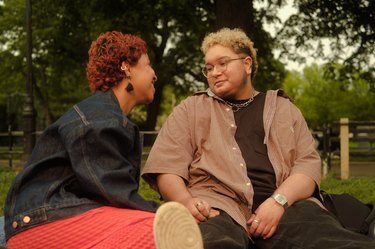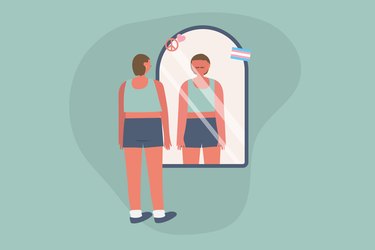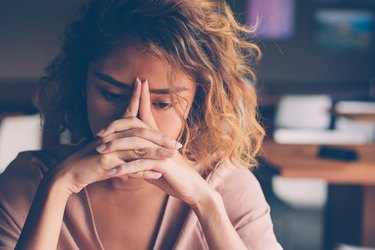
Ask just about anyone in the LGBTQIA+ community and they'll have a story about how someone told them their identity was a mental illness.
In fact, those in the community are more likely to experience suicidal thoughts or attempt suicide than their heterosexual and cisgender peers: Forty percent of transgender adults have attempted suicide in their lifetime, compared to less than 5 percent of the general U.S. population, according to the National Center for Transgender Equality.
Video of the Day
Video of the Day
However, simply having a different sexual orientation or gender identity does not automatically qualify as mental illness, despite how common this misconception is. Many in the community do also have mental health struggles related to their identity. But they are not one and the same.
Why Mental Illness Is More Common in the LGBTQIA+ Community
"Research has shown that individuals who identify as LGBTQIA+ are more than twice as likely as heterosexual men and women to have a mental health disorder in their lifetime," Kiana Shelton, LCSW with Mindpath Health, tells LIVESTRONG.com.
Here are a few possible reasons why.
1. Being in a Gender or Sexual Minority Is a Stressor
In 2003, psychologist and scholar of gender studies Ilan Meyer developed something called the minority stress model, a theory originally about how members of the LGBTQIA+ community have higher prevalence of mental illness than their heterosexual and cisgender peers.
First described in Psychological Bulletin, the model posits that sexual and gender minorities face hostile stressors around their identity and that those stressors negatively affect their health. Most often, these minority stressors take the form of discrimination, prejudice and disparities between the types of help available to sexual and gender majorities versus minorities.
"I typically see more mental health issues within marginalized groups. Individuals within the LGBTQIA+ community tend to sit at the intersection of many overlapping aspects of identity," Shelton says. "For example, one who is a member of the BIPOC and LGBTQIA+ communities. This naturally can increase mental stressors and the likelihood of a mental health disorder."
"Find a place to share lived experiences. It can make the world feel less lonely."
In June 2015 survey results in BMC Public Health, researchers found gender-affirming care, social and familial support and discrimination reduction were linked with lower levels of suicidal ideation among trans Canadians. Those who had greater support in one or more areas of their lives were less likely to experience suicidal ideation than those who had little to no support.
The fact that lacking one or more of these is linked to such a rise in suicidal ideation speaks to the effect that lack of support and increased discrimination has on these individuals.
2. LGBTQIA+ Folks Are More Likely to Seek Help
Higher rates of mental health diagnoses could also be due to higher likelihood of folks seeking help. "Those in the LGBTQ+ community may be diagnosed more with mental health issues because they are more likely to find a therapist," says Katie Schubert, PhD, LMHC, owner of Cypress Wellness Center.
In fact, according to a May 2017 study in the Journal of Homosexuality, LGBTQIA+ people use mental health services 2.5 times more than their heterosexual peers. And it follows that folks who seek help are more likely to be diagnosed with a mental health condition.
One of the biggest problems in the mental health field is help isn't always accessible to those who need it. That means there are many others out there who have mental health issues but don't have any kind of diagnosis or treatment.
3. Past Diagnoses Lead to Modern-Day Stigma
Stigma and discrimination has affected those in the LGBTQIA+ community for hundreds of years. And despite the huge amount of progress we've made in the last few decades, widespread education still isn't available. That means many people today still hold outdated misconceptions, leading to widespread discrimination and increased stressors on minorities.
"Up until 1973, homosexuality was actually a diagnosis in the DSM," Schubert says, referring to the Diagnostic and Statistical Manual of Mental Disorders, which health care professionals use to diagnose a variety of mental health issues. "As a society, we've been slow to let this go — remember, it wasn't until 2015 that the Defense of Marriage Act was even overturned!"
"Prior to that time, identifying as part of the LGBTQIA+ community was seen as a sociopathic personality disorder," Shelton says. "Like our nation's continual effort to correct racism and other '-isms,' we will always be in battle with those who do not want to see the correction of past errored thinking."
After homosexuality was removed from the DSM, it still took another 40 years for the manual to stop classifying being transgender as a mental illness, according to the American Psychiatric Association. But many in society still hold the belief that any minority LGBTQIA+ identity is a mental condition instead of simply a different way of being.
4. Coming Out Isn't a One-Time Thing
Even within the community, there's this idea that coming out is a one-and-done process, that once you publicly come out, you don't have to do it anymore.
"Within my practice, many clients share on average four to five different coming out stories, all that come with their own set of unique stressors," Shelton says.
Coming out can be incredibly difficult, especially if those doing it have reason to believe they won't be accepted when they do. There are many young LGBTQIA+ folks who don't do anything concerning their identity until after they've moved out, for fear of losing their homes, for example.
5. A Lack of Education Creates More Stigma
Because education still hasn't reached many areas of the country, there are still plenty of myths about the LGBTQIA+ community that may increase risk of mental health issues. One of the most harmful myths is that having an LGBTQIA+ identity is a choice and can be reversed via conversion therapy.
"There are a lot of individuals who believe sexuality is changeable with the right 'interventions,'" Schubert says. "This is often called 'conversion therapy.' There is no scientific backing to conversion therapy, and it is, in fact, very harmful."
This so-called treatment conditions LGBTQIA+ people to associate shame and pain with their identity, which not only does not work, it can worsen mental health issues, including suicidal thoughts and attempts, according to May 2020 research in the American Journal of Public Health.
How to Get Help
Because belonging to the LGBTQIA+ community is seen by some as trendy, people might think getting help and support is easier than it actually is.
"Another myth is that with today's access to technology it's not hard for members of the LGBTQIA+ community to easily find supportive access to mental health care," Shelton says. "However, many report that it is still very hard to find affirming mental health support."
We need systemic changes to the mental health care system in the U.S. to better support LGBTQIA+ Americans, and it shouldn't fall on individuals who need help to try to fight that system. But in the meantime, these tips may offer some relief.
1. Seek Out Affirming Support
The best thing you can do for your mental health is to get support — from a friend, family member, colleague, teacher or anyone else you feel you can trust. Having someone who accepts you for who you are without judgment can help with any feelings of shame you might have around your identity.
Along with having someone in your life you feel you can trust, you'll want to find a therapist who has experience working with LGBTQIA+ people. Look for a therapist trained to help you navigate the discrimination and struggles that many in the community face.
Related Reading
2. Look for Reduced-Cost Services
Traditional therapy can get expensive fast, and given that many people have a hard time paying their rent, therapy just isn't possible for everyone. However, that doesn't mean LGBTQIA+ folks don't have options.
"There are many resources for free or reduced-cost therapy services," Schubert says. "Cypress Wellness Center actually provides free/reduced-cost services for residents of Florida. Check out group practices in your area, or not-for-profit agencies specializing in mental health services."
3. Find Community
Therapy also isn't the only option for support.
"Look for local LGBTQIA+ support groups and organizations," Shelton says. "Even in rural areas, I have still seen communities exist." Many gather online, too, meaning you can access support from anywhere.
"Having at least one safe space of like-minded individuals can make a significant difference in your mental health," Shelton says. "Find a place to share lived experiences and [have] those experiences be normalized. It can make the world feel less lonely."
- Annual Reviews in Clinical Psychology: "Mental Health in Lesbian, Gay, Bisexual, and Transgender (LGBT) Youth"
- Pew Research Center: "A Survey of LGBT Americans"
- GLSEN: "The 2019 National School Climate Survey"
- FBI: "2019 Hate Crime Statistics: Victims"
- Journal of Psychiatric Research: "Substance use among sexual minorities in the US – Linked to inequalities and unmet need for mental health treatment? Results from the National Survey on Drug Use and Health (NSDUH)"
- Transgender Health: “Mental Health Diagnoses Among Transgender Patients in the Clinical Setting: An All-Payer Electronic Health Record Study”
- Voices of Youth Count: "Missed Opportunities: LGBTQ Youth Homelessness in America"
- National Center for Transgender Equality: "2015 U.S. Transgender Survey"
- BMC Public Health: "Intervenable factors associated with suicide risk in transgender persons: a respondent driven sampling study in Ontario, Canada"
- Journal of Homosexuality: "Patterns of Mental Health Care Utilization Among Sexual Orientation Minority Groups"
- American Psychiatric Association: "Gender Dysphoria Diagnosis"
- American Journal of Public Health: "Sexual Orientation Change Efforts, Adverse Childhood Experiences, and Suicide Ideation and Attempt Among Sexual Minority Adults, United States, 2016-2018"
Is this an emergency? If you are experiencing serious medical symptoms, please see the National Library of Medicine’s list of signs you need emergency medical attention or call 911.



